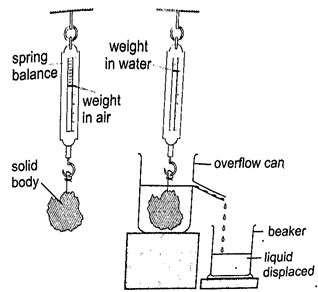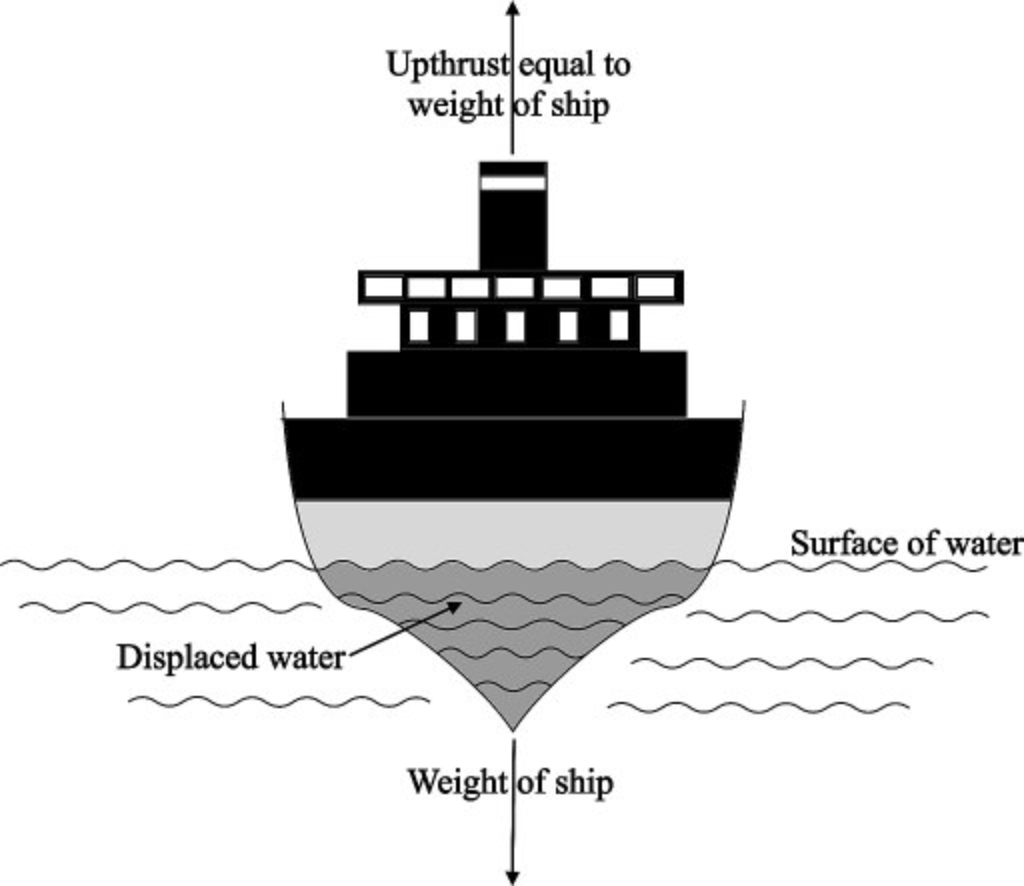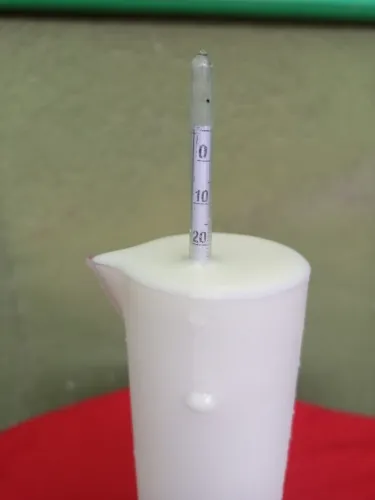Archimedes Principle
Subject: Science

Overview
According to Archimedes' Principle, the upthrust of an object in a liquid is equal to the weight of the liquid it has displaced. Weight and upthrust, which are based on the volume of liquid displaced, determine whether an object will float or sink. According to the law of floating, for an object to float in a liquid, its weight must equal the weight of the liquid it is dislodging. This idea applies to a wide range of air- and liquid-related phenomena. According to Archimedes' principle, a boat's displacement of water equals its own weight, and the thrust it receives from the water equals the weight of the boat. This idea also applies to fish, air, boats, and submarines. Similar to lactometers, hydrometers use upthrust absorption to determine the relative density of liquids. Air in the atmosphere exerts less of an upthrust on objects than water because of its lower density. For instance, the pressure that the air creates causes balloons filled with helium gas to float in the air. The balloon rises with decreasing air density and falls as it cools.

The upthrust applied to a stone submerged in water is equal to the weight of the water that has been displaced. Thus, the Archimedes Principle is proven. For instance, the figure illustrates that the weight of the water displaced and the upthrust applied to the solid object submerged in water (4N) are equal.
The Greek mathematician, who was born in 287 BC, is Archimedes. The upthrust of an object immersed in a liquid, whether fully or partially, is equal to the weight of the liquid that the object has displaced, as per Archimedes' Principle. This theory is true for all fluids, not just liquids. Algebraically,
Upthrust (U) = Weight of liquid displaced (W)
U = mg = Vpg
Because density of liquid (p) = \(\frac {Mass\:(m)}{Volume\:(V)}\)
The volume of liquid displaced, density, and acceleration due to gravity are represented, respectively, by V, 'p', and g in the equation above.
The amount of liquid that an object in a liquid displaces determines how much upthrust the object experiences. Similarly, the upthrust on an item equals the weight of the displaced liquid, based on Archimedes' principle. As a result, an object's ability to float or sink in a liquid is determined by its weight as well as its upthrust, which is determined by the volume of liquid displaced.
Floatation
The object will float on the liquid if its density is lower than the liquid's density. However, it is impossible to determine whether an object floats or sinks simply by comparing its density to that of a liquid.
Observation of the State of Sinking and Floating

Aluminum has a density of 2700 kg/m3, which is 2.7 times that of water. When the foil sinks in water, it can be deduced. However, the aluminum foil that was preserved as a sheet floats on the water, per the activity's outcome. As a result, an object's ability to float or sink in a liquid is dependent not only on the substance's density but also on the shape of the object and the force that is applied to it when it is submerged in the liquid.
The forces operating on an object in exactly opposite directions are its weight and upthrust. The object floats in the liquid when the upthrust cancels the object's weight, resulting in zero resultant force. An object floating in a liquid may be entirely submerged beneath the liquid's surface. Only the portion of the object that is submerged moves the liquid when it is partially floating. An object's weight must match the weight of the liquid it displaces in order for it to float in the liquid. The law of floating refers to:
Weight of Object = Weight of the Liquid Displaced
This statement holds true for a number of phenomena that happen in the surrounding liquids and air. Here are a few instances:
- Floating in a liquid
 An iron block submerged in water will sink because it is unable to push out the same volume of water that is the same weight as the block, as seen in Figure. A bowl-shaped iron block may shift water to the same extent as its weight. In a similar vein, a ship's hull should be deep, long, and wide. As a result, the ship is able to shift enough water to produce an upthrust equivalent to its weight. For instance, the hull size of a ship carrying 20,000 tons must be able to shift 20,000 tons of water in order to keep the ship from sinking. Iron therefore sinks in water, yet an iron-hulled ship floats.
An iron block submerged in water will sink because it is unable to push out the same volume of water that is the same weight as the block, as seen in Figure. A bowl-shaped iron block may shift water to the same extent as its weight. In a similar vein, a ship's hull should be deep, long, and wide. As a result, the ship is able to shift enough water to produce an upthrust equivalent to its weight. For instance, the hull size of a ship carrying 20,000 tons must be able to shift 20,000 tons of water in order to keep the ship from sinking. Iron therefore sinks in water, yet an iron-hulled ship floats.
The weight of the displaced water in a boat is equal to the boat's weight, much like in a ship. The volume and weight of the water that the boat displaces rise as its lower section gradually dips into the water. The upthrust applied to the boat is equal to the weight of water the boat displaces, according to Archimedes' principle. As illustrated in the figure, the boat descends deeper into the water and moves more water when more people board it. The boat's upthrust grows in tandem with the weight of the displaced water. The increased propulsion supports the weight of the additional people. No further water can be displaced and the upthrust does not rise if the water level reaches the top of the boat. In that instance, the boat sinks as its weight increases. Why does a floating boat sink when a hole forms in its bottom? This idea also holds true for the submarine.

The design of submarines allows them to float both visually beneath the water's surface and above it. When the submarine's blast tank is filled with water, it descends farther beneath the ocean; however, when compressed air forces the water out of the tanks, the weight of the submarine returns to the surface. Fish employ the Archimedes' principle to float and sink in water, just like submarines do. The fish's body volume and upthrust both rise as air is filled in its swim bladder, or air sac. The fish drifts in the direction of the water's surface. Fish, on the other hand, empty their bladders to lessen the upthrust that is applied to their bodies and to decrease their body volume. This facilitates their descent farther into the water.
 A hydrometer is a tool for determining a liquid's relative density. It has a large glass bulb with a heavy metal filling that is connected to a finely calibrated tube. It receives the necessary upthrust and floats vertically on the liquid's surface as a result of its heavy bulb displaces the liquid. High-density liquids exert greater upthrust, which causes the hydrometer to float more. Conversely, the hydrometer dips more if the liquid's density is low. A lactometer is a kind of hydrometer that is used to measure the water content of milk.
A hydrometer is a tool for determining a liquid's relative density. It has a large glass bulb with a heavy metal filling that is connected to a finely calibrated tube. It receives the necessary upthrust and floats vertically on the liquid's surface as a result of its heavy bulb displaces the liquid. High-density liquids exert greater upthrust, which causes the hydrometer to float more. Conversely, the hydrometer dips more if the liquid's density is low. A lactometer is a kind of hydrometer that is used to measure the water content of milk.
- Floating in the Atmosphere
There is upthrust in the air, just like there is in the water. However, air has a far lower density than water, so it exerts a far smaller upthrust on an object than water does.
Let's Think
Why does a balloon filled with helium float in the air?
Both liquids and gases allow objects to float. The upthrust that the air pressure produces causes objects to float or soar through the air. Helium gas-filled balloons are seen flying in the sky. Helium is not as thick as air. The balloon will ascend if the upthrust on it, or the weight of the air displaced by the helium-filled balloon, is greater than the weight of the balloon itself. The upthrust acting on the balloon reduces as altitude rises due to a decrease in air density. Once the balloon reaches a particular height, its weight and upthrust equal each other. The balloon floats in the air as a result. The pressure inside and outside the balloon equalizes at a particular height, and the balloon's volume continues to rise until it eventually explodes.
Air balloons travel in the sky, just like balloons filled with hydrogen or helium. In a hot-air balloon, the air density is lower than that of the surrounding atmosphere. An inflatable balloon of this kind displaces a lot of air, so its upthrust exceeds its weight. The balloon consequently takes off and soars through the sky. The weight of the expelled air, or upthrust, balances the balloon's weight when it reaches its maximum altitude. The balloon then starts to float. A burner is used to regulate the temperature of the air within a balloon that is filled with hot air, causing it to rise or fall in the air. The air density in the balloon drops as the burner's flame heats the air within. The balloon takes off skyward as a result. In contrast, the balloon's air cools and becomes denser when the burner is switched off. The balloon sinks in the air, or drops to the ground, when the air inside it gets sufficiently cold and its weight exceeds the upward force acting on it.
Things to remember
- Archimedes' Principle states that the upthrust of an object in a liquid is equal to the weight of the liquid it has displaced
- The volume of liquid displaced determines an object's weight and upthrust, which determine whether it will float or sink in a liquid.
- The law of floating states that the weight of an object must match the weight of the liquid it displaces for it to float in the liquid.
- Archimedes' principle states that the weight of a boat's displaced water is equal to its weight, and the upthrust applied to the boat is equal to the weight of water it displaces. This principle is applied to boats, submarines, and fish, as they all use the same principle to float and sink in water.
- A hydrometer is a tool used to determine a liquid's relative density, with high-density liquids exerting greater upthrust.
- A lactometer measures the water content of milk.
- Air also has upthrust, but with a lower density than water, it exerts a smaller upthrust on an object.
© 2021 Saralmind. All Rights Reserved.

 Login with google
Login with google